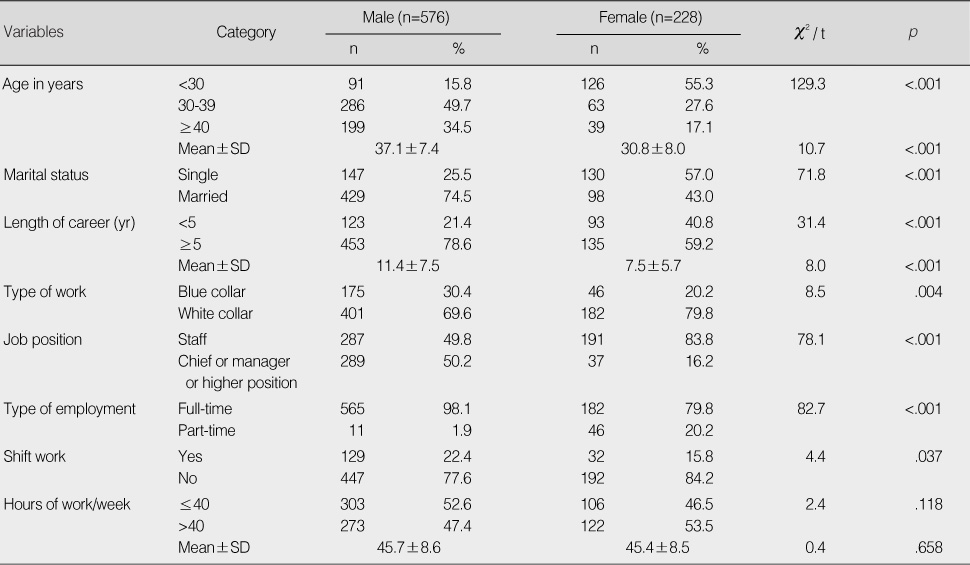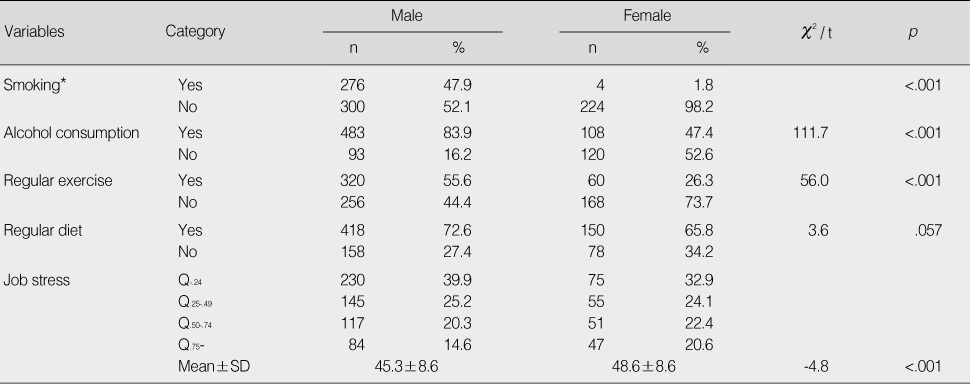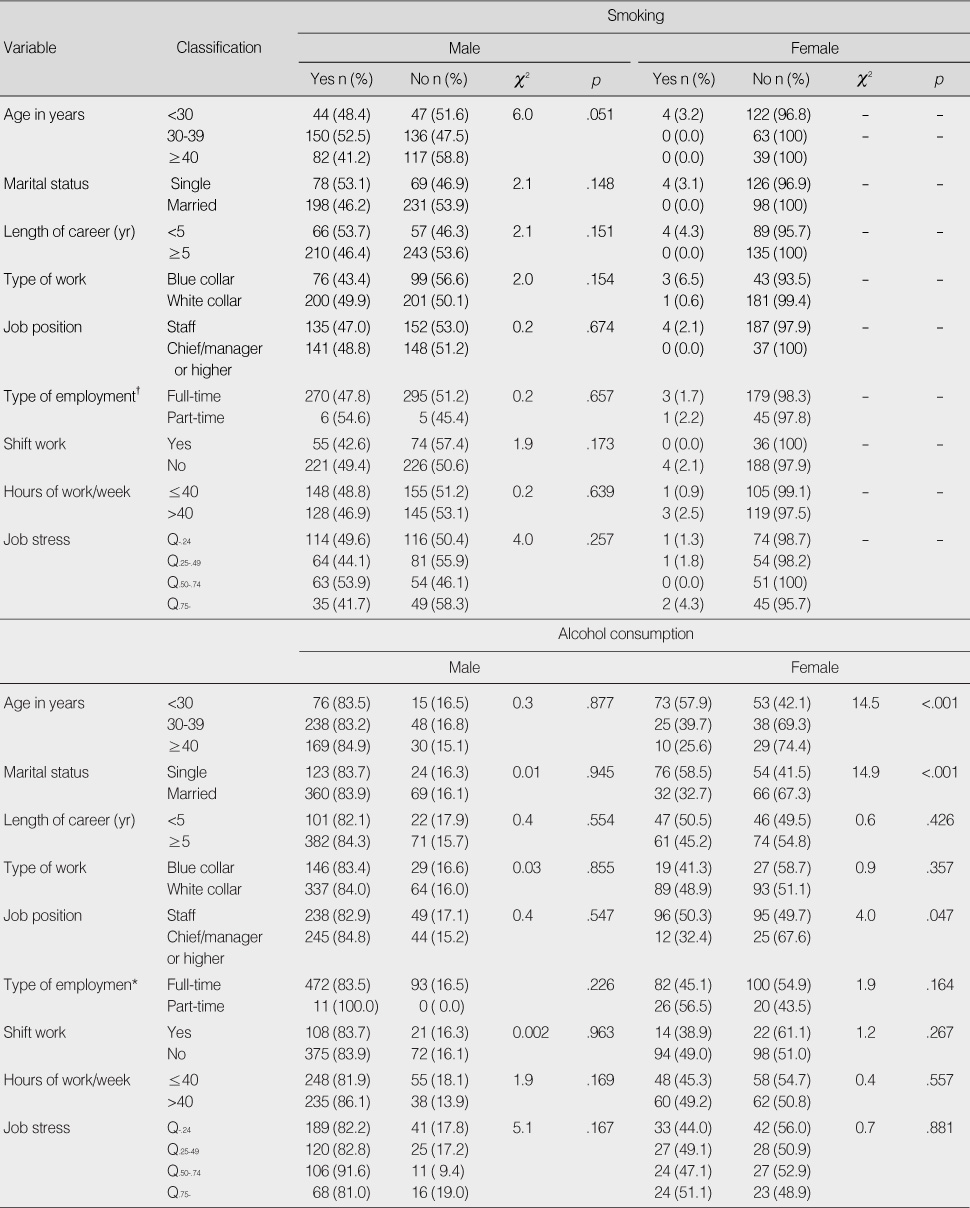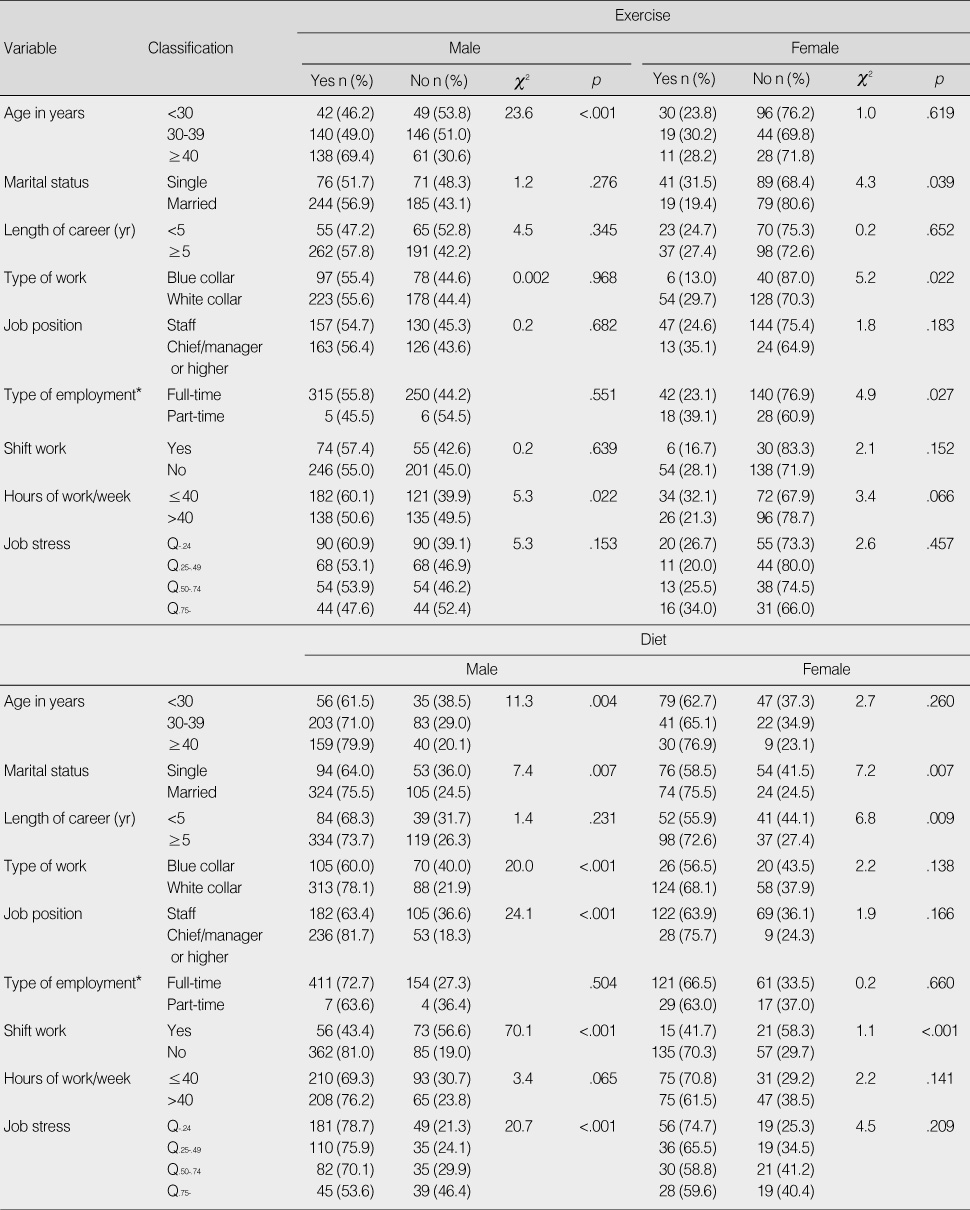Articles
- Page Path
- HOME > J Korean Acad Nurs > Volume 40(6); 2010 > Article
-
Original Article
- Health Behaviors by Job Stress Level in Large-Sized Company with Male and Female Workers
- Hyunju Park, Hye-Sun Jung
-
Journal of Korean Academy of Nursing 2010;40(6):852-862.
DOI: https://doi.org/10.4040/jkan.2010.40.6.852
Published online: December 31, 2010
1Assistant Professor, Department of Nursing, Kyungwon University, Seongnam, Korea.
2Assistant Professor, Department of Preventive Medicine, College of Medicine, The Catholic University of Korea, Seoul, Korea.
- Address reprint requests to: Jung, Hye-Sun. Department of Preventive Medicine, College of Medicine, The Catholic University of Korea, 505 Banpo-dong, Seocho-gu, Seoul 137-701, Korea. Tel: 82-2-2258-7368, Fax: 82-2-532-3820, hyesun@catholic.ac.kr
• Received: December 6, 2009 • Accepted: December 28, 2010
Copyright © 2010 Korean Society of Nursing Science
Abstract
-
Purpose
- This study was done to investigate differences in health behaviors by job stress level in male and female workers in a large-sized company.
-
Methods
- Participants were 576 male and 228 female workers who completed questionnaires. Job stress was measured using the 'Short Form Korean Occupational Stress Scale (SF-KOSS)'. Health behaviors included smoking, alcohol consumption, regular exercise, and diet. Frequency, mean, SD, chi-square test, and multivariate logistic regression using SAS version 9.1 were used to analyze data.
-
Results
- Smoking, drinking and regular exercise rates were not different by job stress level in male or female workers. Only regular diet was significantly different by job stress level in male and female workers. From multivariate analysis, the alcohol consumption rates for female workers differed by marital status. Regular exercise rate was significantly related to age for male workers and type of employment for female workers. After adjusting for demographic and work-related characteristics, regular diet significantly differed by shift work for male workers and marital status and shift work for female workers.
-
Conclusion
- The findings of the study indicate that nursing interventions should be developed to manage job stress to improve diet habits for male and female workers in large-sized companies.
- 1. Chang SJ, Koh SB, Kang DM, Kim SA, Kang MG, Lee CG, et al. Developing an occupational stress scale for Korean employees. Korean Journal of Occupational and Environmental Medicine. 2005;17:297–317.
- 2. Cho KH, Lee DB, Cho YC. Psychosocial distress and its related factors among clerical public officers. Korean Journal of Occupational and Environmental Medicine. 2007;19:26–37.ArticlePDF
- 3. Cho TR. Workers' job stress status and related factors: Using Korean occupational stress questionnaire short form. Korean Journal of Occupational Health Nursing. 2006;15:58–71.
- 4. Choi ES, Ha Y. Work-related stress and risk factors among Korean employees. Journal of Korean Academy of Nursing. 2009;39:549–561.ArticlePubMed
- 5. Choi SK, Lee KS, Lee JW, Koo JW, Park CY. Health behavior practices and needs for health promotion program according to shift work pattern in subway workers. Korean Journal of Occupational and Environmental Medicine. 2003;15:37–51.ArticlePDF
- 6. Cunradi CB, Lipton R, Banerjee B. Occupational correlates of smoking among urban transit operators: A prospective study. Substance Abuse Treatment, Prevention, and Policy. 2007;2:36. PubMedPMC
- 7. Ezoe S, Morimoto K. Behavioral lifestyle and mental health status of Japanese factory workers. Preventive Medicine. 1994;23:98–105.ArticlePubMed
- 8. Green KL, Johnson JV. The effects of psychosocial work organization on patterns of cigarette smoking among male chemical plant employees. American Journal of Public Health. 1990;80:1368–1371.ArticlePubMedPMC
- 9. Han AK, Cho DS. A study on physiological parameters, health perception, and health behavior of adults in Kyungi province area. Journal of Korean Academy of Nursing. 2001;31:631–640.ArticlePDF
- 10. Härenstam AB, Theorell TPG. Work conditions and urinary excretion of catecholamines: A study of prison staff in Sweden. Scandinavian Journal of Work, Environment & Health. 1988;14:257–264.Article
- 11. Kang K, Sung J, Kim CY. High risk groups in health behavior defined by clustering of smoking, alcohol, and exercise habits: National health and nutrition examination survey. Journal of Preventive Medicine and Public Health. 2010;43:73–83.PubMed
- 12. Kim AK. The study on health behavior among Korean adults. Journal of Korean Academy of Nursing. 1998;28:931–940.ArticlePDF
- 13. Kim EK, Kim BG, Park JT, Km HR, Koo JW. Factors affecting the health promotion activities of workers. Korean Journal of Occupational and Environmental Medicine. 2007;19:56–64.ArticlePDF
- 14. Kim GS. Work stress and related factors among married working women in the manufacturing sector. Journal of Korean Academy of Community Health Nursing. 2003;17:212–223.
- 15. Kim SH, Lee WH, Kang DH, Park JH, Min SG, Nho JH. Perceived stress, life style, health status indicators in medical center employees. Journal of Korean Academy of Community Health Nursing. 2006;17:407–418.
- 16. Kim SY. A study on the relationship between practice of physical training and job stress of labour. Journal of Kijeon Women's University. 1991;11:1–15.
- 17. Lee YK, Jung HS, Jhang WG. The relationship between working time and job stress. Korean Journal of Occupational Health Nursing. 2006;15:115–125.
- 18. Lerman C, Glanz K. Glanz K, Rimer BK, Lewis FM. Stress, coping, and health behavior. In: Health behavior and health education: Theory, research, practice. 2002;San Francisco, CA, Jossey-Bass. 139–148.
- 19. Lim SH, Lee DU, Bae JI, Sung NJ, Park KH. Relationship between stress and alcohol intake of male employees in a workplace. Dongguk Journal of Medicine. 2003;10:233–239.
- 20. Ministry of Health and Welfare. Health Plan 2010. 2005;12;Seoul, Author.
- 21. Nam SD. A study of job stress, health perception and health promoting life style among the community health nurses. Korean Journal of Occupational Health Nursing. 2007;16:89–97.
- 22. Nishitani N, Sakakibara H, Akiyama I. Eating behavior related to obesity and job stress in male Japanese workers. Nutrition. 2009;25:45–50.ArticlePubMed
- 23. Stress at Work. National Institute for Occupational Safety and Health. 1999;12 30 Retrieved October 16, 2009. from http://www.cdc.gov/niosh/docs/99-101/.
- 24. van Egeren LE. The relationship between job strain and blood pressure at work, at home, and during sleep. Psychosomatic Medicine. 1992;54:337–343.ArticlePubMed
- 25. Worker Health Chartbook 2004. National Institute for Occupational Safety and Health. 2004;09 15 Retrieved August 22, 2010. from http://www.cdc.gov/niosh/docs/2004-146/detail/imagedetail.asp@imgid44.htm.Article
- 26. Yi Y, Jung HS. Analysis on female workers' job stress in sales and retail industries. Korean Journal of Occupational Health Nursing. 2009;18:22–32.
REFERENCES
Figure & Data
REFERENCES
Citations
Citations to this article as recorded by 

- Sense of coherence promotion and occupational and family stress mitigation may improve heart health behaviors in middle-aged working women: a structural equation modelling approach
Ji Hyun Moon, Eunhye Seo
Frontiers in Public Health.2024;[Epub] CrossRef - Smoking Awareness and Intention to Quit Smoking in Smoking Female Workers: Secondary Data Analysis
Eun-Hye Lee, Sun-Hwa Shin, Goo-Churl Jeong
International Journal of Environmental Research and Public Health.2022; 19(5): 2841. CrossRef - Job Stress and Cardiometabolic Lifestyle Modification Behaviors Among Workers in High-risk and Low-risk Workplaces
Jiyeon Jung, Jina Choo, Sooyeon Park, Jihyun Moon, Songwhi Noh
Journal of Occupational & Environmental Medicine.2021; 63(6): e346. CrossRef - The Relationship between Parenting Stress and Health Promotion Behavior of Working Women: Mediating Effect of Supporting Resources
Gwijin Lee, Jinhwa Lee, Bokim Lee
Journal of Korean Academy of Community Health Nursing.2021; 32(4): 529. CrossRef - A Study on Influence Factors of the Job Stress on Job Satisfaction and Job Performance
Hye Kyung Kim, Sung-Soo Kim
Journal of Health Informatics and Statistics.2019; 44(1): 41. CrossRef - Relationship of Sleep Quality, Physical Stress, Psychological Stress, and Job Stress among Residents
So-Young Yoo, Young-Ah Choi, Young-Kyu Park, Sung-Min Cho, Kyung-Shik Lee, Ga-Young Joo, Hyun Keun Lee
Korean Journal of Health Promotion.2017; 17(1): 9. CrossRef - Prevalence of Chronic Diseases according to Health Behavior of Manufacturing Workers
Jung-Young Kim, Eun-Ju Lee, Soon-Rim Suh
The Korean Journal of Health Service Management.2017; 11(1): 107. CrossRef - Mediating Role of Psychological Capital in Relationship between Occupational Stress and Turnover Intention among Nurses at Veterans Administration Hospitals in Korea
Hee-Yun Yim, Hyun-Ju Seo, Yoonhyung Cho, JinHee Kim
Asian Nursing Research.2017; 11(1): 6. CrossRef - The Effect of Non-regular Employment on the Health Behaviors, Mental Health and Quality of Life: Data from the Korea National Health and Nutrition Examination Survey 2013
Seong Eun Kim, Yeong Sook Yoon, Yun Jun Yang, Eon Sook Lee, Jun Hyung Lee, Dong Jun Kim, Jung Il Kim, Dai Jung Yeo, Ji Yeon Lee, Eun Gyoung Song
Korean Journal of Stress Research.2016; 24(3): 127. CrossRef - The Impact of Job Stress on Smoking and Cessation of Hospital Male Employee
JunHyung Lee, Eon Sook Lee, Dong Jun Kim, Seon Young Kweon
Journal of the Korean Society for Research on Nicotine and Tobacco.2016; 7(1): 19. CrossRef - Predictors of Health-Promoting Behavior Associated With Cardiovascular Diseases Among Korean Blue-Collar Workers
Won Ju Hwang, Oi Saeng Hong, Sally H. Rankin
Asia Pacific Journal of Public Health.2015; 27(2): NP691. CrossRef - Characteristics and Factors Associated with Problem Drinking in Male Workers
Eun Kyung Lee, Ok Soo Kim, Ji Yeon Hong
Asian Nursing Research.2015; 9(2): 132. CrossRef - Effects of Job Stress and Supervisory Support on Depression of Care Givers in Elderly Care Facilities
Ju Hee Hwang, Sungyeau Choi, Hyunju Park
Korean Journal of Occupational Health Nursing.2015; 24(4): 352. CrossRef - Eating and stress at work: The need for public health promotion intervention and an opportunity for food product development?
Barbara J. Stewart-Knox
Trends in Food Science & Technology.2014; 35(1): 52. CrossRef - The Factors related to Dyslipidemia and Hypertension among Male Office Workers
Eun Kyung Lee, Ok Soo Kim
Korean Journal of Adult Nursing.2013; 25(4): 432. CrossRef - The Factors of Oral Health Impact profile of workers -Industrial workers in Gyeong-Nam province-
Jeong-Dan Cha, Kyeung-Ae Jang
Journal of the Korea Academia-Industrial cooperation Society.2012; 13(10): 4604. CrossRef
Health Behaviors by Job Stress Level in Large-Sized Company with Male and Female Workers
Health Behaviors by Job Stress Level in Large-Sized Company with Male and Female Workers
Demographic and Work-related Characteristics of Participants by Gender
Health Behaviors and Job Stress by Gender
*Fisher's Exact Test.
Relationships etween Job Stress and Health Behaviors by Bivariate Analysis
*Fisher's Exact Test.
Relationships between Job Stress and Health Behaviors. Adjusted OR (95% CI)
Table 1
Demographic and Work-related Characteristics of Participants by Gender
Table 2
Health Behaviors and Job Stress by Gender
*Fisher's Exact Test.
Table 3
Relationships etween Job Stress and Health Behaviors by Bivariate Analysis
*Fisher's Exact Test.
Table 4
Relationships between Job Stress and Health Behaviors. Adjusted OR (95% CI)
 KSNS
KSNS
 E-SUBMISSION
E-SUBMISSION




 Cite
Cite

